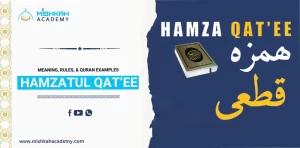Learning to read the Quran in Arabic requires a profound understanding of the Arabic language itself. The Arabic language is one of the most complex languages to master. However, for the love of Allah (SWT) and His Holy Book, many Muslims around the world strive to learn the language to recite Quran beautifully.
The best way to begin is by getting help from a Quran tutor. It would help if you also learned the Arabic alphabet, learn the Quranic Arabic basics from Noorani Qaida, use the Madinah Arabic Book 1 for solving Arabic exercises, and more. As you can see, there are multiple ways to learn Arabic; however, learning how to do it isn’t easy.
8 Tips to Learn How to Read the Quran in Arabic
Table of Contents
ToggleHere are some tips shared by Mishkah Academy tutors to learn to recite the Quran in Arabic properly.
1. Take Help from a Quran Tutor
Taking help from a Quran tutor is important because they guide you through the exact pronunciation and rules of reading Arabic, especially when it comes to the Quran. A tutor ensures you learn Tajweed—the proper way of reciting each letter with its unique sound and emphasis. This is crucial because slight mistakes in pronunciation can change the meaning of the words. Enrolling in an online Quran recitation course provides you with the opportunity to receive expert guidance, as the tutor can also explain the grammar, vocabulary, and specific Quranic contexts, helping you understand the text better.
Here are areas where a Qari can help:
- Correcting pronunciation (Makharij)
- Teaching Tajweed rules
- Enhancing fluency in reading
- Explaining the meanings of verses
- Providing structured practice
2. Learn the Arabic Alphabet
Learning the Arabic alphabet is essential for reading the Quran because it forms the foundation of understanding how each letter sounds and connects in words. Mastering the alphabet will help you read, pronounce, and eventually recite the Quran with ease.
| Arabic Letter | Pronunciation Guide |
| أ | A short, light “a” sound from the throat like in “apple” |
| ب | Soft “b” sound, like the English “b” in “bat” |
| ت | Sharp “t” sound, tip of the tongue touching the teeth |
| ث | “th” sound as in “think” |
| ج | “j” sound, as in “jungle” (Egyptian dialect: hard “g”) |
| ح | Deep, raspy “h” sound from the middle of the throat |
| خ | Guttural “kh” sound, similar to the “ch” in “Bach” |
| د | Light “d” sound, tip of the tongue touching the teeth |
| ذ | “th” sound as in “this” |
| ر | Rolled “r” sound from the front of the mouth |
| ز | “z” sound, like in “zebra” |
| س | Soft “s” sound, like in “sun” |
| ش | “sh” sound, like in “she” |
| ص | Strong, emphatic “s” sound, pronounced from deep in the mouth |
| ض | Strong, emphatic “d” sound from the sides of the tongue |
| ط | Strong, emphatic “t” sound, pronounced deeper than “ت“ |
| ظ | Strong “th” sound, deeper and heavier than “ذ“ |
| ع | Guttural “a” sound, produced deep in the throat |
| غ | Guttural “gh” sound, similar to a French “r” |
| ف | Light “f” sound, like in “fun” |
| ق | Strong, guttural “q” sound, produced at the back of the throat |
| ك | Light “k” sound, like in “kite” |
| ل | Soft “l” sound, tongue touches the roof of the mouth |
| م | “m” sound, like in “moon” |
| ن | “n” sound, like in “nest” |
| ه | Soft “h” sound, like in “hat” |
| و | “w” sound, like in “water”; sometimes “oo” like in “moon” |
| ي | “y” sound, like in “yes”; sometimes “ee” like in “see” |
3. Start Learning the Quranic Arabic Basics from Noorani Qaida
Learning Quranic Arabic basics from Noorani Qaida is important because it teaches you the foundation of Arabic pronunciation and reading. Noorani Qaida starts with teaching how to pronounce each letter correctly and gradually builds up to joining letters to form words. This is especially useful for beginners as it introduces the rules of Tajweed (the correct way to recite the Quran), helping you learn how each letter should sound when reciting the Quran. For those looking to recite Quran for beginners, Noorani Qaida provides a structured and effective starting point.
Here’s how Noorani Qaida can help:
- Teaches the correct pronunciation of Arabic letters (Makharij)
- Introduces basic Tajweed rules
- Helps in reading short and long vowels
- Builds fluency in joining letters to form words
- Gradually moves from single letters to complete Quranic verses.
4. Use Madinah Arabic Book 1 and Finish All Exercises
Using Madinah Arabic Book 1 is important because it systematically teaches the basics of Arabic grammar, vocabulary, and sentence structure, which are crucial for understanding Quranic Arabic. This book starts with simple words and sentences and gradually builds your understanding through practice. The exercises focus on learning how to identify nouns, verbs, and prepositions, and how to construct basic Arabic sentences.
Some key exercises include:
- Matching Arabic words with their meanings.
- Forming simple sentences.
- Filling in missing words.
- Understanding singular and plural forms.
5. Associate Yourself with the Quranic Text
To truly connect with the Quran, incorporating daily practices of writing, reading, and memorizing its verses can be highly beneficial. Here are some specific examples of how to do this:
-
Writing the Quranic Ayahs:
Surah Al-Fatiha (الفاتحة 1:1-7):
“بِسْمِ اللَّهِ الرَّحْمَـٰنِ الرَّحِيمِ (١) الْحَمْدُ لِلَّهِ رَبِّ الْعَالَمِينَ (٢) الرَّحْمَـٰنِ الرَّحِيمِ (٣) مَـٰلِكِ يَوْمِ الدِّينِ (٤) إِيَّاكَ نَعْبُدُ وَإِيَّاكَ نَسْتَعِينُ (٥) اهْدِنَا الصِّرَٰطَ الْمُسْتَقِيمَ (٦) صِرَٰطَ الَّذِينَ أَنْعَمْتَ عَلَيْهِمْ غَيْرِ الْمَغْضُوبِ عَلَيْهِمْ وَلَا الضَّالِّينَ (٧)”
-
Reading and Reciting:
Surah Al-Ikhlas (الإخلاص 112:1-4):
“قُلْ هُوَ اللَّهُ أَحَدٌ (١) اللَّهُ الصَّمَدُ (٢) لَمْ يَلِدْ وَلَمْ يُولَدْ (٣) وَلَمْ يَكُنْ لَهُ كُفُوًا أَحَدٌ (٤)”
-
Memorizing:
Surah Al-Kawthar (الكوثر 108:1-3):
“إِنَّا أَعْطَيْنَاكَ الْكَوْثَرَ (١) فَصَلِّ لِرَبِّكَ وَانْحَرْ (٢) إِنَّ شَانِئَكَ هُوَ الْأَبْتَرُ (٣)”
6. Learn Classical Arabic for Strong Quranic Grammar Foundation
Learning Classical Arabic is crucial for understanding the deeper meanings and nuances of the Quranic text. Classical Arabic is the formal version of the language used in the Quran, which is different from modern spoken Arabic. It focuses on the precise grammar and structure of Arabic, which helps in grasping the context and interpretation of verses.
For example, understanding how verbs and nouns change based on tense and case will allow you to understand the Quran’s message accurately. Learning Classical Arabic gives you the tools to appreciate the beauty and complexity of the Quran in its original language.
7. Immerse Yourself in Arabic Content
Associating yourself with Arabic content in daily life, such as watching Arabic news, and reading newspapers, or articles, is essential because it helps you become familiar with the language outside of a religious context. This will build your vocabulary, improve your listening and reading skills, and make you comfortable with the rhythm and flow of Arabic.
8. Use a Quran App to Keep Track of Your Progress Consistently
Using a Quran app is important because it helps you stay consistent and organized while learning to read the Quran in Arabic. The app allows you to track your progress, set daily reading goals, and listen to correct recitations. This way, you can ensure that you’re making steady improvement in your reading and pronunciation.
Apps to consider:
- Quran Companion
- Tajweed Quran
- Ayat – Al Quran
Conclusion
Learning to read the Quran in Arabic is a rewarding journey that requires dedication, practice, and guidance. You can steadily improve your recitation skills by following steps like learning the Arabic alphabet, studying from resources like Noorani Qaida and Madinah Arabic, and using helpful apps to track your progress. For beginners, Mishkah Academy stands out as the best source to learn to read Quran online, offering expert Quranic tutors with years of experience who can guide students from the UK, USA, Canada, Australia, Germany, and across Europe with personalized lessons.






